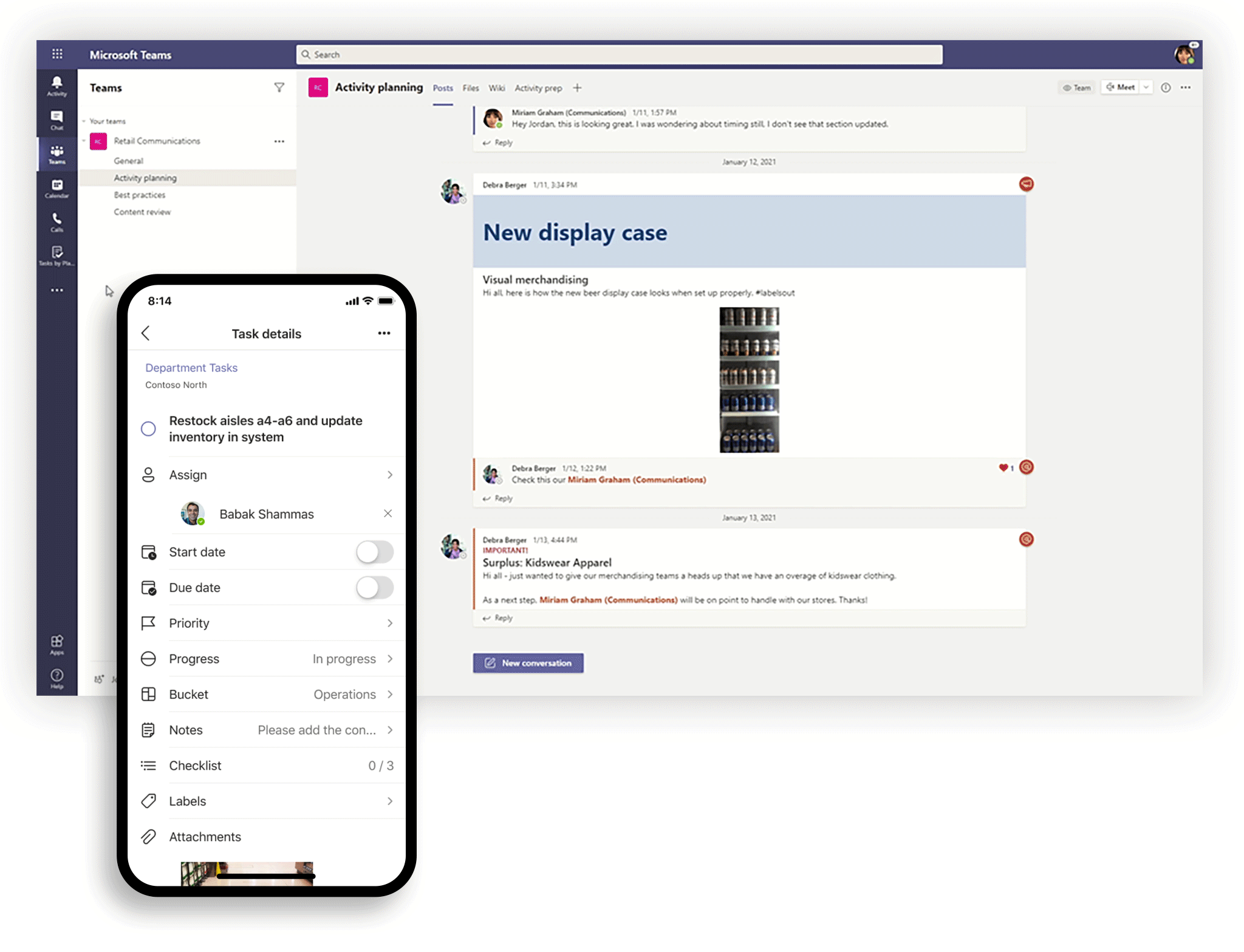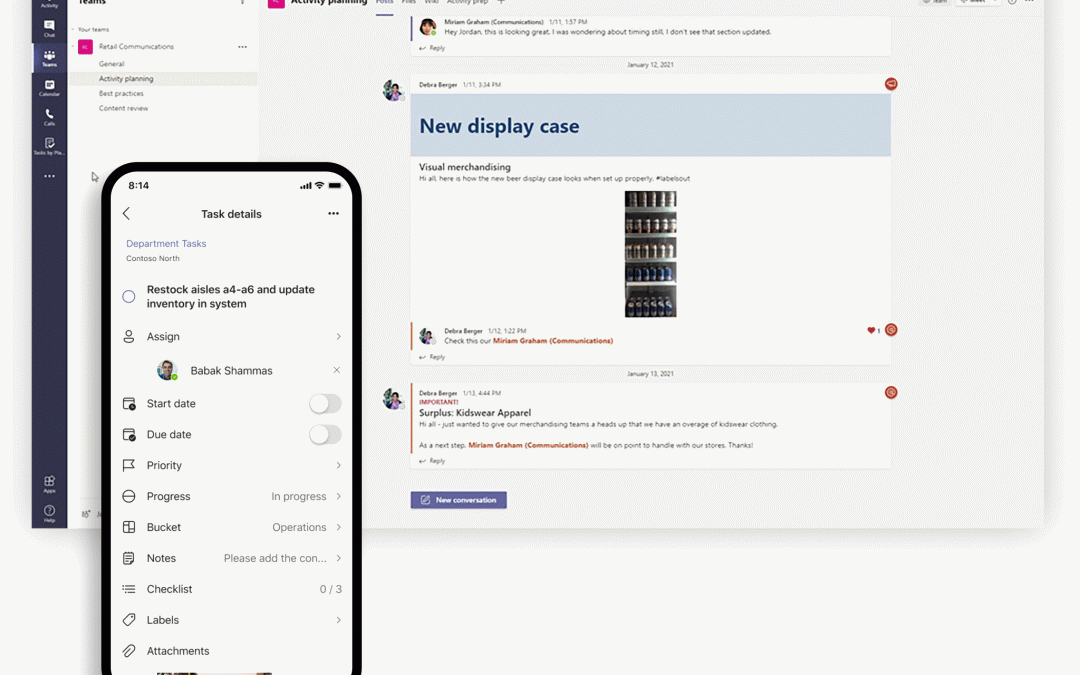This article is contributed. See the original author and article here.
If there’s one thing we learned in 2020, it is that frontline workers are essential in today’s world. As companies realize how important they are, this time, they are bringing them along the digital transformation journey. There is no excuse for these workers to be left on the sidelines anymore.
Here are 8 new features that make frontline workers, managers, and IT’s jobs a little easier.
One tool to meet frontline worker needs
Whether working in back-to-back shifts where hand-offs cannot occur in person, connecting with corporate employees or consulting with remote company experts – Microsoft Teams has your frontline workers covered. In fact, Teams daily active usage more than doubled since March, primarily driven by chats/channels activity, which resembles frontline worker behavior.
1. Tasks Publishing – As the need for corporate offices to better communicate and work with their frontline workforce becomes top of mind, task publishing lets companies create tasks centrally at the corporate level and publish those tasks to different locations, specific store layouts or other customizable attributes of their frontline teams. For example, leadership for a nationwide retailer can create tasks for the reopening of their stores, attach relevant documents like a planogram, send that list to only the affected store locations, and then track progress against the assigned tasks. Managers can easily assign tasks to individual employees, while frontline workers can see a simple prioritized list of those tasks on their personal or company-issued mobile device. Task publishing is now generally available. Learn more about task publishing here.

2. SMS sign-in – employees are able to sign in to their Azure Active Directory (Azure AD) account using one-time SMS codes—reducing the need to remember usernames and passwords. Once enrolled, the user is prompted to enter their phone number, which generates an SMS text with a one-time password. SMS sign-in is a single sign-on (SSO) experience, enabling frontline workers to seamlessly access all the apps they are authorized to use. This new sign-in method can be enabled for select groups and configured at the user level in the My Staff portal—helping to reduce the burden on IT. Click here to learn more.
3. @mention by shift group – Tagging by shift connects you to the right people faster. This new feature enables teams to take the guesswork out of knowing the names of on-shift employees and automatically assigns users with tags matching their schedule in the Shifts app in Teams, backed by major workforce management systems like AMiON, BlueYonder, and Kronos. Use this @mention tag to start a chat or call, or to just notify everyone on a channel.
Tagging by shift is rolling out now and will be fully available by Jan 31. Learn more about how to start using @mention by shift group here.
Supporting frontline managers
4. Delegated user management through My Staff portal – Frontline managers can approve password resets and enable employees to use their phone numbers for SMS sign-in, all via a single customizable portal enabled by IT. With this tool, managers can unblock staff issues—reducing the burden of identity management on IT, and keeping employees connected to the apps they need on the job. Click here to learn more.
5. Digitize manual processes with the Power Platform – Power Apps allow you to create custom low code apps for your frontline workers. The relative simplicity of building these apps allow you to be responsive to the needs of your business, including many firstline scenarios that don’t have technology solutions today. And when combined with automated workflows built with Power Automate, you can digitize and streamline entire processes. For example, Power Apps and Power Automate can totally transform a customer service recall process by alerting store members on Teams via an automate workflow of an item that needs to be pulled from shelves. The frontline workers can then monitor recall alerts and flag new issues with products using a custom app built with Power Apps. Click here to learn more!
Simplifying IT
Bring time to value benefits by streamlining the deployment process and tailoring a frontline team’s collaboration experience. See what Teams templates and policy packages can do for you.
6. Policy Packages – With frontline worker and frontline manager policy packages, IT administrators can easily assign pre-defined policies and policy settings tailored for their frontline workforce. Policy packages create a simple, centralized, and consistent way to manage your Frontline workforce, no matter how big. This month, we are launching group assignment for policy packages via PowerShell and coming soon, group assignment via Teams Admin center.
Availability: These new policy packages are available by default in the IT Admin Center and in PowerShell. Learn more about setting up and customizing the policy packages for Firstline Workforce here.
7. Team Templates – With Teams templates, you can create effective teams faster and more easily than ever. Users can choose from common business scenarios, such as Employee Onboarding and/or industry-specific templates, like Retail – manager collaboration and Organize a store. Each team template comes with pre-defined channels, tabs, and apps. Coming soon are team template policies which allow IT administrators to hide/show specific team templates for users in their organization. This allows admins to tailor the content for business needs. For example the IT administrator could only show retail templates or only show a set of retail + custom team templates, etc.
Custom team templates empower admins to create the right collaboration space for users in their organization. Learn more about creating a template from scratch, from an existing team, from an existing template, and team templates using Microsoft Graph. Teams templates policies will be rolling out soon.
8. Manage shared devices with Endpoint Manager – Microsoft Intune and Configuration Manager are now part of a unified management platform known as Microsoft Endpoint Manager. You can choose to enroll your Android Enterprise (AE) dedicated devices into Microsoft Intune with Azure AD shared mode automatically configured. For more information: Customize and configure shared devices for Firstline Workers at scale – Microsoft Tech Community
Looking ahead
We look forward to sharing the latest innovations as we approach Microsoft Ignite! This is just the beginning in our journey to empower every frontline worker in every organization to achieve more. We look forward to sharing more announcements in future blogs. Don’t forget to check out the newest Microsoft Mechanics video covering the latest frontline worker features in Teams!
Brought to you by Dr. Ware, Microsoft Office 365 Silver Partner, Charleston SC.



Recent Comments